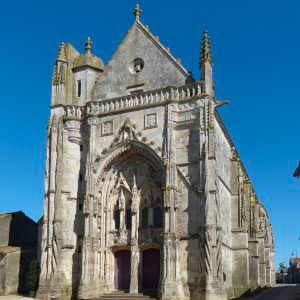
The Commandery of the Antonines of Saint-Marc-La-Lande is one of the most beautiful treasures of the Gâtines region. Located on the pilgrimage route to Santiago de Compostela, this architectural complex was home to monk healers who specialized in treating “Le Mal des Ardents” or “St. Anthony's Fire,” caused by ergot. These monks welcomed the poor, the sick, and pilgrims in the 17th and 18th centuries.
The Antonine order of monks arrived in La Lande around 1260, when only a chapel existed on the site of the village. The parish was then located in a place called “Saint Marc,” and the current village was “La Lande de Saint Marc.”
During the Revolution, the commandery's property was sold as national property and purchased by a private individual who used the commandery and the church for his farm. Damage was then caused.
The owner ceded the commandery and the church to the municipality so that the latter could be returned to worship in 1843. The town hall and the mixed school were installed in the commandery.
At the end of the 19th century, major renovation work gave the collegiate church its current appearance.
In 1983, the municipality decided to carry out further restoration work, supported by a local association, ARAL. Work began on the church in 1985, carried out by a group of around ten young people from the T.U.C., supported by summer youth work camps. It lasted two years and was followed by a huge renovation of the commandery, which was in danger of falling into ruin.
The collegiate church of Saint Marc-la-Lande, a listed historical monument, whose construction can be dated to the early 16th century, is the most important Flamboyant Gothic building in the Deux-Sèvres department.
It is particularly remarkable for its façade and south side.
It suffered the ravages of the Wars of Religion and the French Revolution, and its turbulent history is one of destruction and rebirth.
Today, the Commandery has been restored and is very much alive, welcoming more than 10,000 visitors each year. It has once again become a place of welcome, encounters, and discovery.
The conservatory orchard
A particularly pleasant, peaceful, and relaxing place, it features 107 varieties of apples, 58 varieties of pears, 18 varieties of grapes, and 17 varieties of roses.
Created during the renovation of the complex, its purpose is to preserve the memory of many species that have become rare. It is now maintained by municipal staff. Every year, during the Christmas Market, visitors leave with some fruit from the orchard offered by the municipality, and the rest of the harvest is donated to the food bank.
The medicinal plant garden
Like the orchard, it is a recent creation. It is a young collection of local plants known for their healing properties but which can also be dangerous. Traditionally, our ancestors harvested them for medicinal purposes. To treat burns, the Antonines used a preparation composed of 14 plants, some of which are present in the garden.
You can guess the healing properties of the medicinal plants that make up the garden, created to commemorate the Antonines' vocation. Depending on the season, you can taste forbidden fruits in the conservation orchard, which shelters and protects various species of apples and pears that have sometimes been forgotten.
Commanderie des Antonins
1, Rue des Antonins
79310 Saint-Marc-la-Lande
Tel.: +33 (0)5 49 63 43 31
https://www.tourisme-deux-sevres.com/activite/commanderie-des-antonins/




